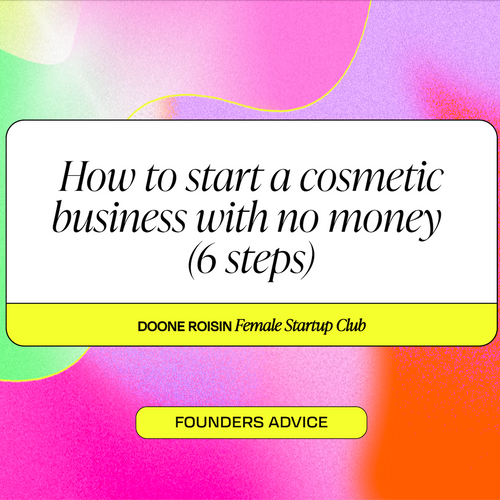
When starting a business raising capital is always challenging, but it can be especially difficult for women-led businesses. Even though female founders are increasingly gaining traction in venture capital, there are still unique hurdles when seeking funding for entrepreneurship.
Women entrepreneurs face challenges such as difficulty raising significant seed funding and unconscious biases. To stand out when seeking venture capital, women should be prepared to have well-researched pitches and business plans with attainable targets as well as strong marketing strategies.
This guide will provide actionable advice to help female entrepreneurs navigate the venture capital space and successfully raise money for their businesses, so read on!

What Does It Mean To Raise Capital?
Raising capital is raising money from outside sources to start or grow a business. This could mean getting investments from venture capitalists, angel investors, or crowdfunding platforms. It can also mean securing loans from banks or government programs.
Raising capital involves several steps. First, entrepreneurs must determine their funding needs and create a business plan that outlines the company's goals and strategies.
Then, they must identify potential sources of capital and determine which type of financing makes the most sense for their business. Some of the most common types of capital include debt financing, equity financing, crowdfunding, and grants.
The Difference Between Debt and Equity
Having access to capital is important to ensure that women-led businesses have the resources they need to do well. Understanding debt and equity is critical to raising the capital necessary to grow your business.
Debt financing involves borrowing money from investors and then repaying them with interest over time.
This type of funding usually comes in the form of a loan or line of credit. The most significant benefit of debt financing is that the business does not have to give up any ownership in return for the capital it receives. Debt can also be easier to obtain than equity because there is less risk to the investor.
Equity financing means selling company shares to potential investors. This allows businesses to raise funds without taking on debt, which means they are not obligated to pay back the investors.
However, it also means that the business must give up some ownership of its company in exchange for the capital they receive. ]
For female entrepreneurs, finding access to capital is often challenging. Companies like us at Female Startup Club provide valuable resources and connections to help women access venture capital and other forms of funding.
Different Ways To Raise Money
When raising capital, women entrepreneurs have several options:
-
VC (Venture capital)
-
Angel investment
-
Crowdfunding platforms
-
Loans from financial institutions such as banks or credit unions
-
Grants and government programs
-
Women-focused funds
-
Bootstrapping (self-financing)
What is Venture Capital?
VC or Venture capital is a form of financing provided by investors to finance start-up companies with the potential for long-term growth. Venture capitalists provide money for businesses in exchange for equity or ownership in the company.
These investments are typically made at different stages of business development, from pre-seed and seed rounds to series A, B, C, and D. Each round involves different amounts of money, depending on the company's objectives and the investors' risk tolerance.
What is Angel Investment?
Angel investment is financing provided by private individuals to help finance a business in exchange for equity or ownership in the company. This type of funding typically comes from high-net-worth individuals with the funds to invest in business growth.
Angel investors often provide early-stage financing for businesses that don't yet qualify for venture capital and are willing to take more risks than traditional venture capitalists. Angel investments are usually made at the pre-seed and seed stages of business development.
I recently took part in an Angel Investing program hosted by the UNSW, Sydney, and learned so much on the topic. If you want to learn more about Angel Investing but don't know where to start, pop your details here to be in the loop and we'll send you our cheat sheet when the program ends.
How Long Does It Usually Take To Raise Capital?
Raising capital can take months – even years – to find the right investors for your business and secure funding. To fast-forward the process, you should have a well-thought-out business plan and a clear understanding of your target market.
The timeline will depend on the financing you seek and your ability to prove your business is worth investing in. Furthermore, having a well-crafted pitch deck, an active investor network, and good market research are all essential when raising capital.
How Hard Is It To Raise?
How hard it is to raise capital typically depends on several factors, but female entrepreneurs find it much harder to raise funds than male entrepreneurs.
These difficulties are further compounded when institutionalized racism and other factors intersect with the bias again women. Women in business have to work twice as hard to get the bare minimum consideration when receiving capital.
The Issues That Come With Raising Venture Capital For Women
Unfortunately, there's still a gender gap regarding access to venture capital and other forms of funding, and women are much less likely to receive venture capital than men. According to a report from the Harvard Business Review, only 2.3% of total venture capital went to women-led businesses in 2020.
The gender disparities in venture capital can be attributed to several factors. These include gender bias, limited networks and resources, and a lack of understanding of how the venture capital system works.
Women-led businesses often face unique challenges when it comes to raising capital.
-
Investors may not take women-led businesses as seriously as male-led businesses.
-
The venture capital industry is still male-dominated, which may make it difficult for women to access funding.
-
There is a lack of female investors who may be more inclined to invest in women-led businesses.
-
Women may be seen as too inexperienced or not knowledgeable enough about business and finance.
-
The fundraising process can take months, so women entrepreneurs should be prepared to persistently seek funding opportunities.
-
Women entrepreneurs may not be familiar with the latest fundraising trends or tactics.
-
Women can face additional scrutiny and have to prove themselves more than male founders.
Women entrepreneurs must be aware of these issues and take steps to mitigate them to maximize their chances of success.
What Questions Will Investors Ask That You Should Prepare For?
When applying for venture capital or angel investment, women entrepreneurs should be prepared to answer questions such as the following:
-
What problem does your product/service solve?
-
What is the size of the market opportunity?
-
Who are your competitors, and how do you plan to differentiate yourself in the market?
-
How will you monetize your product/service?
-
What is your competitive advantage?
-
What is your growth potential, and what milestones have you achieved?
-
What is your team structure and experience?
-
What have been some of the biggest successes and challenges in launching your business?
-
Do you have any intellectual property protections in place
How You Can Stand Out?
Women entrepreneurs should also be prepared to stand out from the crowd when seeking funding.
To do this, women should focus on building relationships with investors and other women in business. This could include joining female-focused networks such as Female Startup Club or attending networking events hosted by venture capitalists and angel investors.
To stand out, female entrepreneurs should also make their pitch memorable.
Make sure you know your industry and create a polished and professional presentation showcasing your value proposition. Also, provide real data and proof points to back up your claims, and come armed with relevant customer stories and testimonials.
As Jaclyn Johnson, founder of Create & Cultivate and more recently VC-firm New Money Ventures mentioned on Female Startup Club recently:
“Get people excited about the vision of your business and why you’re the best possible person, it comes down to storytelling and marketing opportunity.”
Alternative Ways To Access Funding As a Female Founder
Female entrepreneurs often face unique challenges in raising capital and getting investments.
However, with the right strategies and resources, there are alternative ways to access funding that can help level the playing field. Here are a few options to explore as a female founder:
Wayflyer
Wayflyer is an online platform that helps female-led businesses raise capital through crowdsourced equity investments.
Companies can create profiles on Wayflyer that explain their business model, team, and plans, and investors can then browse these profiles and choose companies they would like to support. This makes it easier for female entrepreneurs to find potential investors and increase visibility for their businesses.
Clearco/Clearbanc
Clearco offers a suite of capital solutions for female founders, including capital for growing businesses, pre-Series A funding, and debt financing. They are committed to helping female entrepreneurs succeed by providing tailored financing and advisory services. Clearco also offers free educational resources on navigating the venture capital landscape.
Shopify Capital
Shopify Capital is an excellent option for women-led businesses looking to scale their operations and expand their customer base.
Through this program, female entrepreneurs can access loans up to $1 million to cover expenses like marketing, inventory purchases, hiring costs, and more. Businesses don't need to pay back Shopify Capital until they generate revenue from their Shopify store.
Other Funding Options:
-
Grants and awards: Many grants, fellowships, and awards are available specifically to women entrepreneurs.
-
Crowdfunding: Platforms such as Kickstarter, Indiegogo, and GoFundMe are great options for women entrepreneurs who want to raise money quickly.
-
Small business loans: Women entrepreneurs can also apply for small business loans from traditional lenders such as banks, credit unions, and online lenders.
-
Friends and family: Female founders can always turn to their friends and family for financial support.
-
Bootstrapping: Another option is to bootstrap your business, which means self-funding your venture with personal savings and revenue generated from the business.
What are Convertible Notes?
Convertible notes involve a process by which investors loan money and receive equity in return. They are effectively a debt instrument that converts in subsequent financing rounds. Convertible notes allow women-led businesses to raise capital without going through the process of valuing the company.
What is Pre Seed, Seed, Series A, B, C, and D?
There is some funding terminology that female entrepreneurs must know:
-
Pre-Seed Funding. This is the first type of funding women entrepreneurs typically seek when starting their businesses. It usually comes from friends, family, and other early-stage investors. This round of funding is used to develop a prototype, build an MVP (Minimum Viable Product), or conduct market research.
-
Seed Funding. Seed funding is the second stage of venture capital financing for women-led businesses. It is typically used to build a product, develop marketing strategies, and grow its customer base.
-
Series A Funding. Series A funding is the third stage of venture capital financing for women-led businesses. This round of funding is used to scale the business and expand into new markets like e-commerce.
-
Series B Funding. This is the fourth stage of venture capital financing for women-led businesses. This round of funding is used to further develop and refine the product, acquire new customers, and expand into new markets.
-
Series C Funding. The fifth stage of venture capital financing for women-led businesses — this round of funding is used to invest in long-term projects. Businesses may use this funding to expand into new markets or develop new products and services.
-
Series D Funding. This is the sixth stage of venture capital financing for women-led businesses. This round of funding is typically used to fund acquisitions, repurchase shares, and pay off debt.
Outreach Templates: Sample and Effective Tips
Most women entrepreneurs struggle with finding the right words when reaching out to potential investors. Here is a short-form template women entrepreneurs can use.
Subject Line: A Unique Opportunity for Women Investors
Dear Investor,
I am the founder of <your business name>, a women-led start-up focused on <describe your product or service>. We are currently seeking investment to help us scale and grow our business. I believe our business has the potential to generate an ROI that would be attractive to investors.
If you are interested in learning more about our business, please don't hesitate to reach out. I am happy to answer any questions or provide additional information as needed.
Thank you for your time and consideration.
Regards,
<Your Name>
Practical Tips on Outreach Templates
Once women entrepreneurs have crafted their outreach emails, there are still a few practical tips they should keep in mind:
-
Make sure to personalize the email for the investor you are reaching out to.
-
Keep the subject line and body of the email concise.
-
Include links to your website, social media accounts, and other relevant material.
-
Make sure to follow up with investors promptly.
-
Avoid making requests that are too broad or vague.
-
Include data and information about your startup’s potential for growth and profitability.
-
Include testimonials and case studies from other women-led businesses
-
Be transparent and open to negotiation.
-
End the email on a positive note.
-
Be sure to proofread your emails for any typos or errors before sending them out.

Index of Terms Used in Fundraising That You Should Know
When it comes to fundraising, women entrepreneurs should familiarize themselves with the terminology used in the venture capital space.
-
Convertible notes: A type of loan that converts into equity at a later date when certain milestones are met.
-
Angel investors: Individuals who invest in start-ups, typically providing early-stage funding.
-
Venture capital: A type of investment in which a company receives funds from venture capital firms or individual investors.
-
Valuation: The process of determining the worth of startups and companies.
-
Equity: A percentage of a company owned by an investor in exchange for capital.
-
Return on Investment (ROI): The amount earned from an investment after taxes and other costs are considered.
-
Exit strategy: The company's plan for how it will eventually divest from the business.
Final Thoughts
Raising capital for women-led businesses can be a unique challenge, but it is possible. With research, preparation, and an understanding of the venture capital space, women entrepreneurs can showcase their startups and stand out from the competition.
With the right approach and understanding of the venture capital space, women entrepreneurs can access the funding they need to take their businesses to the next level.



